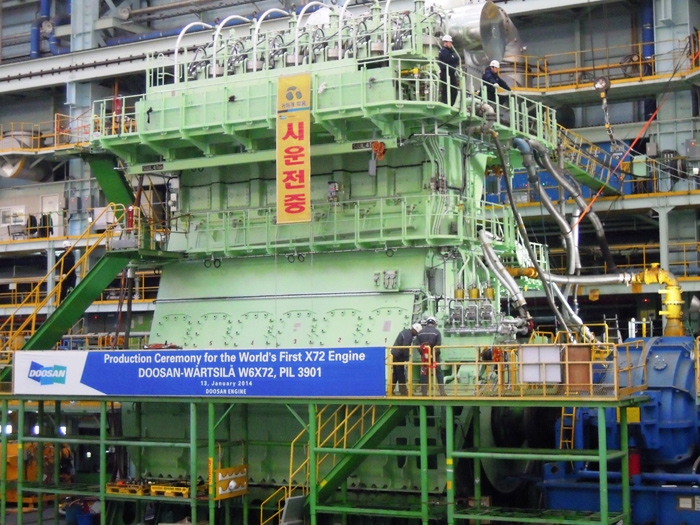
Wärtsilä X72 passes another milestone
Written by Nick Blenkey
JANUARY 14, 2014 — The first Wärtsilä X72 mid-bore, low-speed engine has successfully passed factory acceptance tests, verifying that it fulfils design criteria for performance and functioning and has been accepted by the customer and the classification society, Lloyd’s Register. The tests were carried out at the Doosan Engine Co. in South Korea, where the engines are being produced under license from Wärtsilä.
Wärtsilä launched its low-speed Generation X engine series in May 2011. The Wärtsilä X72 engine offers exceptional efficiency and fuel consumption performance to provide a favorable Energy Efficiency Design Index (EEDI). The improvement in fuel consumptionresults in correspondingly reduced CO2 and NOx emissions.
Thanks to its extended rating field, the Wärtsilä X72 is suited to a broad range of ship types, including Capesize bulk carriers, Suezmax tankers, and feeder/Panamax containerships.
“This is another important milestone for us since this is the first ever Wärtsilä X72 engine to roll off the production line,” says Martin Wernli, Managing Director of Wärtsilä Switzerland and Vice President, Wärtsilä Ship Power, two-stroke. “The fact that it has successfully fulfilled the factory acceptance test requirements means that in every respect it meets our expectations, as well as the expectations of our customers.. We are now moving with great confidence to the full commercialization of this outstanding engine”
Following the completion of this first engine, production of the Wärtsilä X72 is being ramped up rapidly with orders at several licensees, and the next engine’s factory acceptance test is already scheduled for February 2014. Factory acceptance tests are a common practice with all engines delivered to customers.
The Wärtsilä X72 features the company’s electronically time-controlled common-rail technology which has a proven 15 years track record. The flexible fuel injection and exhaust valve operation featured in this technology offer considerable fuel consumption reductions with correspondingly lower levels of exhaust emissions. The system also permits stable running speeds down to 12 per cent of the nominal speed, smokeless operation, and improved control of emissions. The engine has been designed to provide exceptional reliability, extended key component life, and has been optimized for lower engine revolutions.





Leave a Reply
You must be logged in to post a comment.